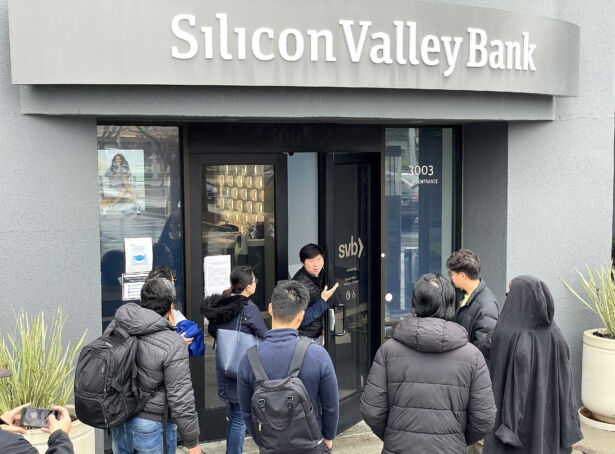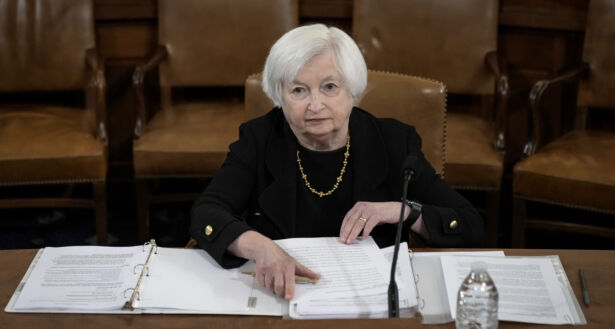President Joe Biden on Sunday issued a statement on the failures of Silicon Valley Bank (SVB) and Signature Bank, insisting that the U.S. financial system is “safe” after the Federal Reserve rolled out an emergency lending program to stabilize the banking system.
It comes after the Federal Deposit Insurance Corporation (FDIC) expanded its deposit insurance coverage at the two failed banks so depositors won’t lose any money.
Biden said in a statement on Sunday that Treasury Secretary Janet Yellen and his top economic adviser Lael Brainard worked with banking regulators to mitigate any potential financial fallout from the failures of SVB and Signature Bank.
“I am pleased that they reached a prompt solution that protects American workers and small businesses, and keeps our financial system safe. The solution also ensures that taxpayer dollars are not put at risk,” Biden said.
“The American people and American businesses can have confidence that their bank deposits will be there when they need them,” Biden added, while pledging to hold those “responsible for this mess” fully accountable.
U.S. financial authorities worked on several fronts to stem any potential fallout from the twin failures, which sparked fears of bank runs and contagion that could threaten broader financial system stability.
‘Systemic Risk Exception’
The FDIC said it will carry out the orderly wind-down of SVB—in a process known as resolution—in a way that “fully protects all depositors” on the basis of a special “systemic risk exception” that lets the FDIC temporarily expand its deposit insurance coverage over and above what’s normally a $250,000 per account cap.
“Depositors will have access to all of their money starting Monday, March 13,” the FDIC said in a joint statement with the Fed and Treasury.
This means that all depositors are set to receive all their money back, rather than facing the prospect of having to take losses on the uninsured portions of their deposits, normally anything above the $250,000 limit.
The same “systemic risk exception” has been adopted for Signature Bank, which was closed Sunday by New York state chartering authorities.
“All depositors of this institution will be made whole,” the FDIC said, adding that, as with the resolution of SVB, “no losses will be borne by the taxpayer.”
The money to reimburse depositors will come from the FDIC’s special deposit insurance fund, which is a kind of rainy day fund that the agency collects from banks in the form of annual insurance premiums, or assessments, over the course of years.
The funds used to make SVB and Signature Bank depositors whole will be replenished by a special assessment on banks, which is a kind of extraordinary insurance premium levied under unique circumstances to allow the FDIC to stay poised to address future bank failures.
While depositors of SVB and Signature Bank will be fully protected and made whole, shareholders of the banks will have to take losses.

Fed Rolls Out Liquidity Support
Separately, the Federal Reserve announced Sunday that it has made available a special emergency liquidity mechanism for depository institutions like banks, credit unions, and savings associations, to help ensure that they have enough money available at hand to meet the withdrawal demands of depositors.
“The Federal Reserve is prepared to address any liquidity pressures that may arise,” the U.S. central bank said in the statement, signaling its determination to nip in the bud any speculation of broader contagion following the shockwave across markets sent by the twin failures of SVB and Signature Bank.
The emergency mechanism, called the Bank Term Funding Program (BTFP), offers loans to eligible depository institutions like banks and credit unions, made against collateral like Treasurys and mortgage-backed securities, under easier terms than the Fed normally provides.
“The BTFP will be an additional source of liquidity against high-quality securities, eliminating an institution’s need to quickly sell those securities in times of stress,” the Fed said.
The BTFP will be bolstered, if the need should arise, by a funding backstop of $25 billion from the Exchange Stabilization Fund, which is managed by Treasury.
The Fed also addressed the decision that the FDIC will cover not just the insured portions of deposits at SVB and Signature Bank but that all depositors will be made fully whole.
“These actions will reduce stress across the financial system, support financial stability and minimize any impact on businesses, households, taxpayers, and the broader economy,” the Fed said.
The central bank added that it’s closely monitoring conditions across the entire financial system and stands ready to take additional steps and deploy its “full range of tools to support households and businesses.”
Biden is expected to deliver more extensive remarks about the twin failures and U.S. banking system resilience on Monday.

Moral Hazard?
Some market participants said the moves by the Fed, the FDIC, and others should bolster sentiment in the short-term but could lead to moral hazard over the long-term.
Moral hazard is the removal of peoples’ incentive to guard against financial risk, encouraging market players to make riskier bets.
“Had the [FDIC], [U.S. Treasury], and [the Federal Reserve] not intervened today, we would have had a 1930s bank run continuing first thing Monday causing enormous economic damage and hardship to millions,” Pershing Square founder Bill Ackman said in a Twitter post.
“More banks will likely fail despite the intervention, but we now have a clear roadmap for how the gov’t will manage them,” he added.
Ackman insisted that the emergency measures—the effective waiving of the $250,000 deposit coverage cap and the emergency liquidity mechanism—was “not a bailout in any form” as investors and bondholders who didn’t “adequately oversee” the failed banks will face losses, not taxpayers.
He added that the moves bolster confidence in the banking sector and reduce the likelihood of runs on America’s handful of “too big to fail” banks that would have put taxpayers on the hook for their bailouts.
Economist Peter Schiff disagreed, arguing in a Twitter post that this “absolutely is a bailout” and that taxpayers will “get the bill in the form of higher inflation.”
Yellen argued Sunday that the U.S. government’s actions aren’t a taxpayer-funded bailout but measures to meet the “needs” of depositors who stand to lose millions in the twin failures.
“We’re not going to do that again,” she said, referring to the types of bailouts that took place during the 2008–09 financial crisis that left taxpayers on the hook.
In an argument that’s typical of opponents of deposit insurance coverage, Schiff also argued that the existence of deposit insurance itself contributes to moral hazard and that “having a sound banking system requires banks to compete with customers based on safety.”
Numerous studies, including one by the FDIC (pdf), have credited deposit insurance systems with contributing to financial system stability while also acknowledging an increased risk of moral hazard.
Deposit insurers have sought to address the risk of moral hazard by such methods as regulatory discipline exercised by bank supervisors and promoting market discipline, in part by adopting a coverage limit that normally exposes some portion of deposits to losses in case of failure.
Rabobank strategists Michael Every and Ben Picton argued in a note that the Fed’s emergency lending facility amounts to “allowing a massive easing of financial conditions as well as soaring moral hazard.”
Goldman Sachs strategists said in a note that “in light of recent stress in the banking system,” they no longer expect the Fed to deliver a rate hike at its next meeting on March 22 and that the future path of interest rates is now under a shroud of “considerable uncertainty.”
From The Epoch Times
